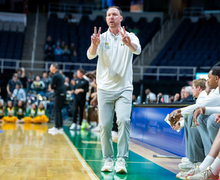Summer courses to help international students adjust to U.S. academic system
A bridge program to acclimate international students to academic and cultural aspects of the United States during the summer is in the works at Syracuse University.
“This campus is really committed to international students and international education exchange,” said Pat Burak, director of the Slutzker Center for International Services.
The program, which Burak described as “75 percent academic,” would enable international transfer students and first-year international graduate students to take two, three-credit courses prior to the start of the fall semester. Courses include one class on library research skills and one class on global leadership, neither of which would count toward a degree. Students would also be able to take summer courses offered through individual colleges at SU.
Between 15-60 students are expected to enroll in the program this summer, Burak said.
“The students are going to have a wonderful opportunity to immerse themselves in the U.S. academic system,” she said. “They’ll get to see Syracuse University in July and August, two of the most beautiful months, and they’ll start practicing their English, which is very important.”
Becoming a pilot bridge program depends on approval by each of the colleges at SU, Burak said. Should the colleges not approve the program as a bridge program, the two courses would be offered independently to whomever wishes to take them.
Although many at SU have suggested the creation of a bridge program in years past, Burak said three barriers have complicated its organization.
First, immigration restrictions prevent international students from entering the United States more than 30 days before the start of an academic program. Second, SU offers limited summer housing, which must be reserved months in advance. And third, summer programs, funded entirely by the student, are expensive. The summer bridge program would cost international students $7,500-$8,000, Burak said.
The currently proposed pilot bridge program came together quickly this year when two faculty members came to the Slutzker Center independently with ideas for summer courses geared toward international students.
“It was a serendipitous confluence of creative ideas,” Burak said.
Martha Garcia-Murillo, a professor in the School of Information Studies, brought forward the idea of a global leadership course. Garcia-Murillo said she started a leadership course through the iSchool seven years ago and noticed international students benefitted the most.
Based on this observation, she began to adjust the curriculum to identify cultural differences and explain how to succeed in the United States. For example, the course will encourage students to interact with professors, participate in group projects and stand out in classes, which are not typically expected or valued actions in other cultures.
“Leadership is actually not something that they value or reward in their cultures,” she said, “and you have to let them understand that this is not the case here.”
Lisa Moeckel, associate dean for undergraduate education at SU Library, proposed the second course on library and research skills. The course will address research methods, academic integrity and familiarize students with the library system.
The content of the course evolved from the many “information literacy” classes the library hosts through writing department classes each year, Moeckel said. If the three-credit format of the class works well this summer, she said she hopes to expand the program to the greater campus community.
International students will especially benefit because library systems in other countries are often very different, said Tarida Anantachai, a resident librarian who works closely with the Slutzker Center. International students may not be accustomed to browsing the stacks and pulling books independently or understanding in what ways librarians can assist with research projects, she said.
This familiarization is important given the high number of international students who use the library, she said.
“We’re hoping that this course will help to support their usage of the different services and people here who are here to help them with the library,” she said.
If the program runs as a pilot this summer, Burak, director of the Slutzker Center, said evaluations would follow in order to improve the program for the future. This would include a comparison of the GPAs of international students who did and did not participate.
“It’s not a huge problem if it doesn’t go forward as a pilot,” Burak said. “I know things take time.”
Published on March 24, 2013 at 11:44 pm





